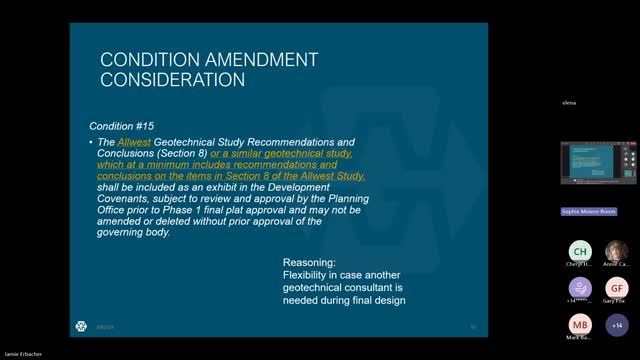Water rights debate heats up over new subdivision plans
August 08, 2024 | Missoula County, Montana
This article was created by AI summarizing key points discussed. AI makes mistakes, so for full details and context, please refer to the video of the full meeting. Please report any errors so we can fix them. Report an error »

During a recent government meeting, significant discussions centered around the water rights and wastewater management for the proposed Grama Valley subdivision, which aims to establish a new residential and commercial community outside the service area of Missoula water and sewer.
Julie Merritt from WGN Group outlined the extensive water rights permitting process required by the Department of Natural Resources and Conservation (DNRC). This process necessitates proving the availability of water, ensuring no adverse impacts on existing water rights, and demonstrating beneficial use. The subdivision will need to establish its own public water supply, which involves rigorous aquifer testing and mitigation strategies to protect existing water rights, particularly in the context of the Clark Fork River Basin.
Bruce Anderson, a senior hydrologist, provided insights into the groundwater situation, revealing that four test wells have been drilled, yielding promising results with flow rates sufficient to meet the subdivision's peak water demand. He emphasized that the likelihood of impacting senior water users is low, thanks to the careful planning and testing conducted.
On the wastewater side, Don Malott from Ethos Civil discussed the implementation of a gravity wastewater collection system, which will include a membrane bioreactor (MBR) facility designed to treat wastewater efficiently. The MBR system is noted for its high-quality effluent, meeting drinking water standards, and will be housed in a building to mitigate odor concerns.
The meeting also addressed the subdivision's overall plan, which includes 218 residential lots and commercial spaces, emphasizing sustainable development and community-focused amenities. However, concerns were raised regarding potential impacts on local traffic, infrastructure, and the preservation of agricultural land. Public comments reflected a divided opinion on the project, with supporters highlighting the benefits of affordable housing and community amenities, while opponents expressed skepticism about the project's impact on local character and resources.
The planning staff recommended approval of the subdivision, contingent on numerous conditions aimed at addressing environmental and community concerns. The proposal is set to move forward, with ongoing discussions about its implications for the local area and its residents.
Julie Merritt from WGN Group outlined the extensive water rights permitting process required by the Department of Natural Resources and Conservation (DNRC). This process necessitates proving the availability of water, ensuring no adverse impacts on existing water rights, and demonstrating beneficial use. The subdivision will need to establish its own public water supply, which involves rigorous aquifer testing and mitigation strategies to protect existing water rights, particularly in the context of the Clark Fork River Basin.
Bruce Anderson, a senior hydrologist, provided insights into the groundwater situation, revealing that four test wells have been drilled, yielding promising results with flow rates sufficient to meet the subdivision's peak water demand. He emphasized that the likelihood of impacting senior water users is low, thanks to the careful planning and testing conducted.
On the wastewater side, Don Malott from Ethos Civil discussed the implementation of a gravity wastewater collection system, which will include a membrane bioreactor (MBR) facility designed to treat wastewater efficiently. The MBR system is noted for its high-quality effluent, meeting drinking water standards, and will be housed in a building to mitigate odor concerns.
The meeting also addressed the subdivision's overall plan, which includes 218 residential lots and commercial spaces, emphasizing sustainable development and community-focused amenities. However, concerns were raised regarding potential impacts on local traffic, infrastructure, and the preservation of agricultural land. Public comments reflected a divided opinion on the project, with supporters highlighting the benefits of affordable housing and community amenities, while opponents expressed skepticism about the project's impact on local character and resources.
The planning staff recommended approval of the subdivision, contingent on numerous conditions aimed at addressing environmental and community concerns. The proposal is set to move forward, with ongoing discussions about its implications for the local area and its residents.
View full meeting
This article is based on a recent meeting—watch the full video and explore the complete transcript for deeper insights into the discussion.
View full meeting
